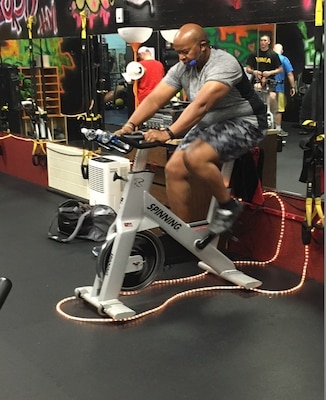By Annette P. Gomes U.S. Army Warrior Transition Command
ARLINGTON, Va., Dec. 13, 2017 — As a policy maker and
administrator in the Army, Command Sgt. Maj. Jerome Wren never expected to end
up in a warrior transition battalion.
“During my 32-year career I have accumulated a few bumps and
bruises, but I have always been able to bounce back or, as we say in the Army,
‘suck it up and drive on,’” Wren said. Known to push himself to the limit in
the past, he says it was time to listen to his body.
“I go where my soldiers go. I’ve had a few injuries while on
training missions and during wartime deployments. I recently returned from
Liberia … where I sustained injuries that brought me to the Fort Campbell
Warrior Transition Battalion,” Wren said.
“It was here I learned about the Adaptive Reconditioning
Program,” he continued. This is one of the best programs currently in the
military. It gets soldiers back in the fight, and [for] the ones that are
deemed medically unable to continue service, it prepares [them] to meet the
challenges of civilian life. However, as I pushed myself mentally, my body told
me it was time to take a knee and reset.”
Reconditioning Through Cycling
As Wren began to recover at the battalion, he fell in love
with cycling, even participating in the 2017 Bluegrass Rendezvous bike ride, a
two-day trek in and around Fort Campbell and the surrounding areas of Kentucky
and Tennessee.
“This was an experience that I will cherish for years to
come,” he said. “It was a grueling ride, considering the many injuries I was
dealing with, but in the end, I finished. This is something that I would have
never have considered doing if it was not for the Adaptive Rehabilitation
Program.”
When he first arrived at the battalion, he said, he thought
it was just a requirement to occupy his time. “But what I came to realize,” he
added, “was this program was staffed by a group of individuals dedicated with
helping each soldier improve their well-being, both physically and mentally.”
Beyond the physical and mental changes that cycling can
provide, Wren said, he learned an important lesson when interacting with his
fellow wounded, ill and injured soldiers.
A Humbling Experience
“Coming to the WTB was very humbling for me, because I have
always been out front and never had to take a knee,” he said. “My intention was
to get here, have my surgeries and get back in the fight. I thought I had it
bad with my injuries, but as I interacted with my fellow wounded warriors and
listened to their stories and observed some of the challenges they faced, it
made me really look at life and career differently.”
Differently is precisely how Wren said he wants others to
view the Adaptive Reconditioning Program, noting that it goes beyond sports
activities.
”The Adaptive Reconditioning Program uses adaptive sports to
strengthen the body, but more so to build mental toughness,” he explained. “The
Fort Campbell site coordinator and the team of therapists and assistants
provide the extra one-on-one physical training, motivation and encouragement
that pushes you to find your new 100 percent.”

No comments:
Post a Comment